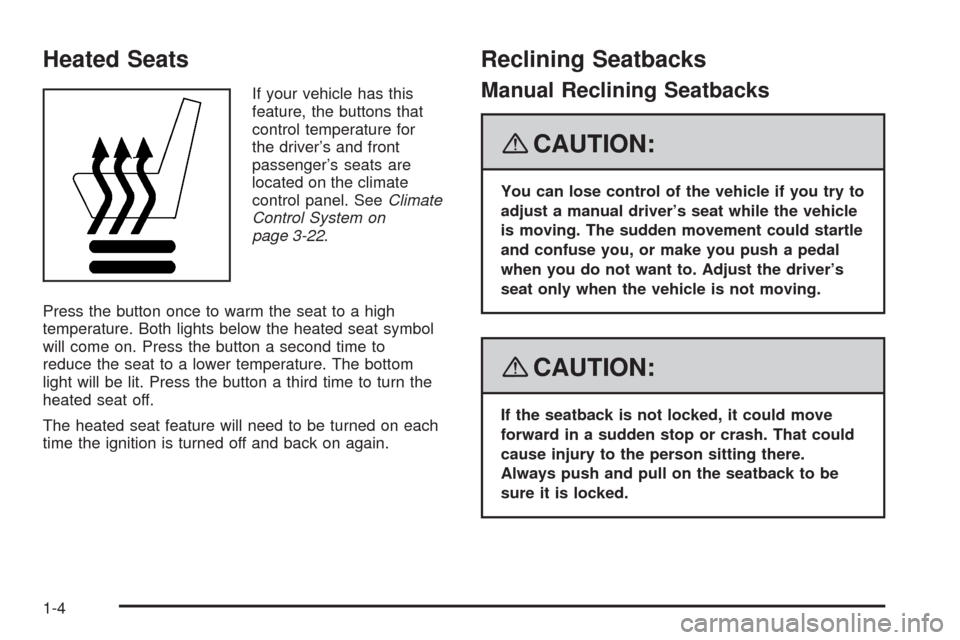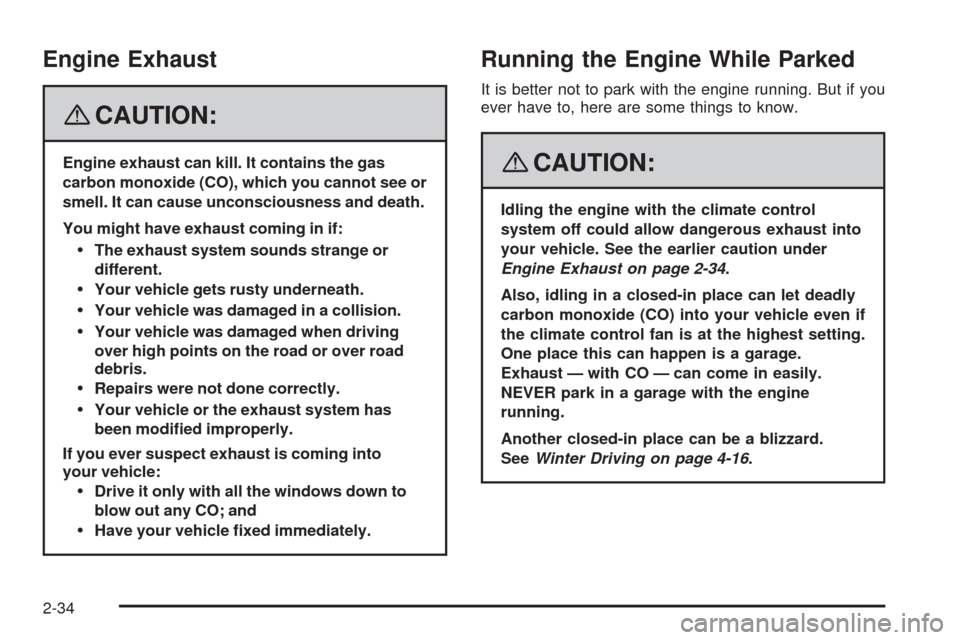2008 CHEVROLET IMPALA climate control
[x] Cancel search: climate controlPage 1 of 400

Seats and Restraint Systems........................... 1-1
Front Seats
............................................... 1-2
Rear Seats
............................................... 1-8
Safety Belts
.............................................1-10
Child Restraints
.......................................1-31
Airbag System
.........................................1-54
Restraint System Check
............................1-68
Features and Controls..................................... 2-1
Keys
........................................................ 2-3
Doors and Locks
......................................2-10
Windows
.................................................2-15
Theft-Deterrent Systems
............................2-18
Starting and Operating Your Vehicle
...........2-21
Mirrors
....................................................2-35
OnStar
®System
......................................2-38
Universal Home Remote System
..................2-41
Storage Areas
.........................................2-48
Sunroof
..................................................2-49
Instrument Panel............................................. 3-1
Instrument Panel Overview
.......................... 3-4
Climate Controls
......................................3-22
Warning Lights, Gages, and Indicators
........3-27
Driver Information Center (DIC)
..................3-44
Audio System(s)
.......................................3-66Driving Your Vehicle....................................... 4-1
Your Driving, the Road, and Your Vehicle
..... 4-2
Towing
...................................................4-26
Service and Appearance Care.......................... 5-1
Service
..................................................... 5-3
Fuel
......................................................... 5-5
Checking Things Under the Hood
...............5-12
Headlamp Aiming
.....................................5-47
Bulb Replacement
....................................5-47
Windshield Wiper Blade Replacement
.........5-52
Tires
......................................................5-54
Appearance Care
.....................................5-90
Vehicle Identi�cation
.................................5-98
Electrical System
......................................5-98
Capacities and Speci�cations
...................5-103
Maintenance Schedule..................................... 6-1
Maintenance Schedule
................................ 6-2
Customer Assistance Information.................... 7-1
Customer Assistance and Information
........... 7-2
Reporting Safety Defects
...........................7-14
Vehicle Data Recording and Privacy
...........7-16
Index.................................................................1
2008 Chevrolet Impala Owner ManualM
Page 8 of 400

Heated Seats
If your vehicle has this
feature, the buttons that
control temperature for
the driver’s and front
passenger’s seats are
located on the climate
control panel. SeeClimate
Control System on
page 3-22.
Press the button once to warm the seat to a high
temperature. Both lights below the heated seat symbol
will come on. Press the button a second time to
reduce the seat to a lower temperature. The bottom
light will be lit. Press the button a third time to turn the
heated seat off.
The heated seat feature will need to be turned on each
time the ignition is turned off and back on again.
Reclining Seatbacks
Manual Reclining Seatbacks
{CAUTION:
You can lose control of the vehicle if you try to
adjust a manual driver’s seat while the vehicle
is moving. The sudden movement could startle
and confuse you, or make you push a pedal
when you do not want to. Adjust the driver’s
seat only when the vehicle is not moving.
{CAUTION:
If the seatback is not locked, it could move
forward in a sudden stop or crash. That could
cause injury to the person sitting there.
Always push and pull on the seatback to be
sure it is locked.
1-4
Page 82 of 400

Remote Vehicle Start
Your vehicle may have a remote starting feature that
allows you to start the engine from outside the vehicle.
It may also start the vehicle’s heating or air conditioning
systems and rear window defogger. When the remote
start system is active and the vehicle has an automatic
climate control system, it will automatically regulate the
inside temperature. Normal operation of these systems
will return after the ignition key is turned to ON/RUN.
Laws in some communities may restrict the use of
remote starters. For example, some laws may require a
person using remote start to have the vehicle in view
when doing so. Check local regulations for any
requirements on remote starting of vehicles.
Do not use the remote start feature if your vehicle is low
on fuel. Your vehicle may run out of fuel.
Your Remote Keyless Entry (RKE) transmitter with the
remote start button provides an increased range of
operation. However, the range may be less while the
vehicle is running. As a result, you may need to
be closer to your vehicle to turn it off, than you were
to turn it on.
There are other conditions which can affect the
performance of the transmitter, seeRemote Keyless
Entry (RKE) System on page 2-4.
/(Remote Start):This button will be on the RKE
transmitter if you have remote start.
To start the vehicle using the remote start feature:
1. Aim the transmitter at the vehicle.
2. Press and release the transmitter’s lock button,
then immediately press and hold the transmitter’s
remote start button for about four seconds or
until the vehicle’s turn signal lamps �ash.
The doors will lock.
When the vehicle starts, the parking lamps turn on
and remain on while the engine is running.
The remote start feature provides two separate starts
per ignition cycle, each with 10 minutes of engine
running time, or one start with a time extension. The �rst
start must expire or be canceled to get two separate
10 minute starts.
If it is the �rst remote start since the vehicle has been
driven, repeat the previous steps, while the engine is
still running, to extend the engine running time by
10 minutes from the time you repeat the steps for
remote starting. The remote start running time can be
extended one time and only after the �rst remote start.
After entering the vehicle during a remote start,
insert and turn the key to ON/RUN to drive the vehicle.
2-8
Page 87 of 400

When you want to open a rear door when the security
lock is on, do the following:
1. Unlock the door using the remote keyless entry
transmitter, if the vehicle has one, the power
door lock switch, or by lifting the rear door
manual lock.
2. Open the door from the outside.
To cancel the rear door security lock, do the following:
1. Unlock the door and open it from the outside.
2. Insert the key into the security lock slot and turn it
so the slot is in the vertical position.
3. Do the same for the other rear door.
Lockout Protection
This feature helps prevent you from locking the doors
while your key is in the ignition. Always remember
to take your key with you when exiting your vehicle.
If the lock switch is pressed on the door that is open and
the key is in the ignition, all of the doors will lock and
then the driver’s door will unlock. A chime will sound
continuously until all doors are closed.
Trunk
{CAUTION:
It can be dangerous to drive with the trunk lid
open because carbon monoxide (CO) gas can
come into your vehicle. You cannot see or
smell CO. It can cause unconsciousness and
even death. If you must drive with the trunk lid
open or if electrical wiring or other cable
connections must pass through the seal
between the body and the trunk lid:
Make sure all other windows are shut.
Turn the fan on your heating or cooling
system to its highest speed and select the
control setting that will force outside air
into your vehicle. See Climate Control
System.
If you have air outlets on or under the
instrument panel, open them all the way.
SeeEngine Exhaust on page 2-34.
2-13
Page 108 of 400

Engine Exhaust
{CAUTION:
Engine exhaust can kill. It contains the gas
carbon monoxide (CO), which you cannot see or
smell. It can cause unconsciousness and death.
You might have exhaust coming in if:
The exhaust system sounds strange or
different.
Your vehicle gets rusty underneath.
Your vehicle was damaged in a collision.
Your vehicle was damaged when driving
over high points on the road or over road
debris.
Repairs were not done correctly.
Your vehicle or the exhaust system has
been modi�ed improperly.
If you ever suspect exhaust is coming into
your vehicle:
Drive it only with all the windows down to
blow out any CO; and
Have your vehicle �xed immediately.
Running the Engine While Parked
It is better not to park with the engine running. But if you
ever have to, here are some things to know.
{CAUTION:
Idling the engine with the climate control
system off could allow dangerous exhaust into
your vehicle. See the earlier caution under
Engine Exhaust on page 2-34.
Also, idling in a closed-in place can let deadly
carbon monoxide (CO) into your vehicle even if
the climate control fan is at the highest setting.
One place this can happen is a garage.
Exhaust — with CO — can come in easily.
NEVER park in a garage with the engine
running.
Another closed-in place can be a blizzard.
SeeWinter Driving on page 4-16.
2-34
Page 111 of 400

Outside Power Mirrors
The controls for the
outside power mirrors are
located on the driver’s
door armrest.
Use the selector switch located below the four-way
control panel to choose either the left or right outside
mirror. Then press any of the four arrows located on
the control pad to move each mirror in the desired
direction.
Adjust each mirror so you can see the side of your
vehicle and the area beside and behind your vehicle.
Outside Power Heated Mirrors
If the vehicle has this feature, when the rear window
defogger is turned on, the heated driver’s and
passenger’s outside power mirrors are warmed to help
clear them of ice, snow and condensation. See
“Rear Window Defogger” underClimate Control System
on page 3-22for more information. Also seeOutside
Power Mirrors on page 2-37for mirror operation.
Outside Convex Mirror
{CAUTION:
A convex mirror can make things (like other
vehicles) look farther away than they really are.
If you cut too sharply into the right lane, you
could hit a vehicle on your right. Check your
inside mirror or glance over your shoulder
before changing lanes.
The passenger side mirror is convex. A convex mirror’s
surface is curved so more can be seen from the
driver’s seat. It also makes things, like other vehicles,
look farther away than they really are.
2-37
Page 125 of 400

Instrument Panel Overview...............................3-4
Hazard Warning Flashers................................3-6
Other Warning Devices...................................3-6
Horn.............................................................3-6
Tilt Wheel.....................................................3-6
Turn Signal/Multifunction Lever.........................3-7
Turn and Lane-Change Signals........................3-8
Headlamp High/Low-Beam Changer...................3-8
Flash-to-Pass.................................................3-9
Windshield Wipers..........................................3-9
Windshield Washer.......................................3-10
Cruise Control..............................................3-10
Exterior Lamps.............................................3-14
Delayed Headlamps......................................3-15
Daytime Running Lamps (DRL)/
Automatic Headlamp System.......................3-16
Fog Lamps..................................................3-16
Instrument Panel Brightness...........................3-17
Courtesy Lamps...........................................3-17
Dome Lamp.................................................3-17
Entry Lighting...............................................3-17Delayed Entry Lighting...................................3-18
Delayed Exit Lighting.....................................3-18
Parade Dimming...........................................3-18
Reading Lamps............................................3-19
Mirror Reading Lamps...................................3-19
Electric Power Management...........................3-19
Battery Run-Down Protection..........................3-20
Accessory Power Outlet(s).............................3-20
Ashtray(s) and Cigarette Lighter......................3-21
Climate Controls............................................3-22
Climate Control System.................................3-22
Outlet Adjustment.........................................3-25
Passenger Compartment Air Filter...................3-26
Warning Lights, Gages, and Indicators
............3-27
Instrument Panel Cluster................................3-28
Speedometer and Odometer...........................3-29
Tachometer.................................................3-29
Safety Belt Reminders...................................3-30
Airbag Readiness Light..................................3-31
Passenger Airbag Status Indicator...................3-32
Charging System Light..................................3-34
Section 3 Instrument Panel
3-1
Page 129 of 400

The main components of your instrument panel are listed here:
A. Air Vent. SeeOutlet Adjustment on page 3-25.
B. Remote Trunk Release Button. See “Remote Trunk
Release” underTrunk on page 2-13.
C. Multifunction Lever. SeeTurn Signal/Multifunction
Lever on page 3-7.
D. Instrument Panel Cluster. SeeInstrument Panel
Cluster on page 3-28.
E. Hazard Warning Flasher Button. SeeHazard
Warning Flashers on page 3-6.
F. Driver Information Center. SeeDriver Information
Center (DIC) on page 3-44.
G. Passenger Air Bag status Indicator. SeePassenger
Airbag Status Indicator on page 3-32.
H. Audio System. SeeAudio System(s) on page 3-66.
I. Exterior Lamps Control. SeeExterior Lamps on
page 3-14.
J. Instrument Panel Brightness. SeeInstrument Panel
Brightness on page 3-17.
K. Traction Control On/Off Button (If Equipped).
SeeTraction Control System (TCS) on page 4-6.L. Tilt Steering Wheel Lever. SeeTilt Wheel on
page 3-6.
M. Steering Wheel Cruise Control. SeeCruise Control
on page 3-10.
N. Hood Release. SeeHood Release on page 5-13.
O. Horn. SeeHorn on page 3-6.
P. Audio Steering Wheel Controls (If Equipped).
SeeAudio Steering Wheel Controls on page 3-86.
Q. Ignition Switch. SeeIgnition Positions on page 2-22.
R. Climate Controls. SeeClimate Control System on
page 3-22.
S. Accessory Power Outlets. SeeAccessory Power
Outlet(s) on page 3-20.
T. Center Console Shift Lever (If Equipped). See
“Console Shift Lever” underShifting Into PARK (P)
on page 2-30.
U. Glove Box. SeeGlove Box on page 2-48.
3-5